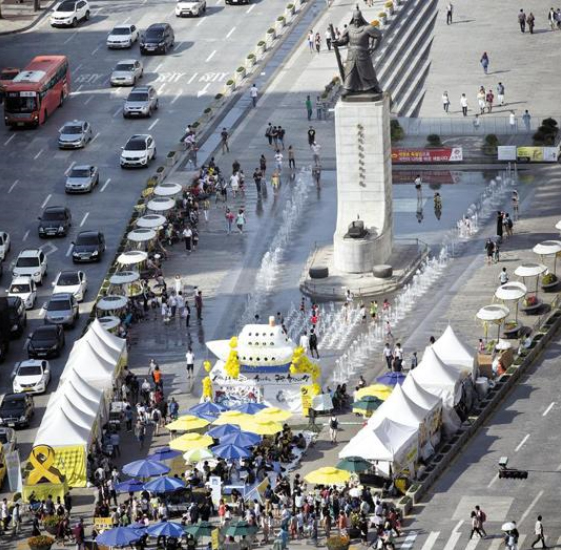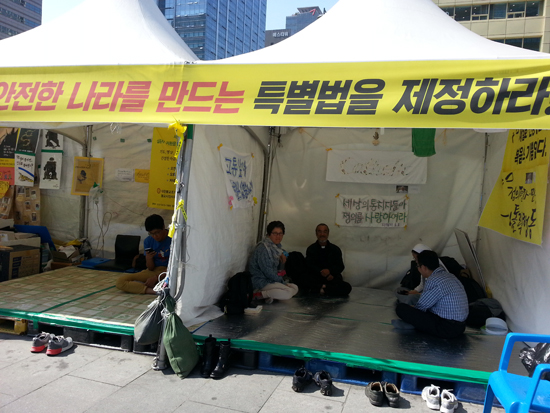I pass by Gwanghwamun square in front of Gyungbok Palace and Gwanghwamun crossroads several times in a day whenever I leave my house. I sometimes walk towards Samchung-dong looking at the signboard of Gwanghwamun to dine out.
While walking, many thoughts pop up on my mind.
There used to be the Central Government Office that was a massive stone building.
My father was moved to Seoul from Pyungyang and had worked as an official of the Department of Commerce and Industry of the Central Government Office. At his age of twenty-nine, he got married with my mother at the hall of the Central Government Office. I think that I overheard about the news article reporting on why the hall was provided as a wedding hall and whenever I pass by the place, I imagine how young and fresh my parents were at that time and what their wedding ceremony looked like, reminding comments by friends of my mother that the guests were so surprised because the bridegroom was stuningly handsome.
I had sometimes showed the building to American and Japanese friends of mine before it disappeared just because it was established under the Japanese colonial rule. Later, one of the American friends was transferred to the Embassy of the United States in Seoul from the U.S. Department of States. When he realized that the buliding dissapeared he mourned for it. It is always regrettable that it was removed. If it had been moved to another place, its history would have been preserved. Further, Gyunggi Provincial Government Office where Japanese tourists had always visited and was located in the opposite of the Central Government Office should also have existed for sightseeing purpose.
I look around the whole area of Gwanghwamun street called Sejong-Ro thoroughly, standing with my back toward the signboard.
This has been my home town since I was little. I have complained of nowhere to go envying others going to rural home towns even in last holiday, but was soon thankful for being here while thinking this place where I had missed while I was in U.S.A. long ago.
The tram route that I followed up to Hyoja-dong when I was very young had disappeared and the image of the old ginko trees-lined street is still vivid in my mind. However, it became an empty square where certain events or demonstrations occur. When I take a taxi on the day when a demonstration occurs, I am frequently frustrated with traffic jam for a while.
There was also a moment of the century.
last August, how we were happy and overwhelmed with the mass presided over by Pope Francisco. It happened just three months ago. I definitely expected that our life would return to daily anxiety after lapsing the holy moment and it did so as I expected.
A line of tents set up by the Sewol ferry-related persons range along Gwanghwamun crossroads.
It has been six months since they were lost in grief. Notwithstanding, I feel as if the Sewol disaster had occurred a long time ago.
How can we alleviate their sorrow?
How can the slogans that are hanging here and there be removed and citizens walking by it calm down? If the Sewol Special Act is enacted and all of their demands are accepted, they can be peaceful?
Whenever I pass by them by taxi, most taxi drivers certainly say, ‘For a while, all the Korean people have expressed sorrow so much. How do they dare to do such a thing?’ It is pitiful that they did not consider it seriously as the same Korean.
The Admiral Yi Sun Shin Statue established in 1968 is still standing at the center of Gwanhwamun crossroads. Once, there was a joke saying that the statue looks down the signboard of Kukje Cinema all day long. Now it is forced to look down the tents in the air pollution emitted by the terribly increasing number of cars.
Deoksoo Bakery and Crown Bakery where I felt happy tasting breads when I was young do not exist any more. I used to walk holding hands of my friend after school and be treated to a cup of water and fruits by her after forcing my way into the front door of her Korean traditional house (Hanok) in Naesoo-dong. Naesoo-dong where Hanoks used to be concentrated in has been changed into a large apartment complex.
The whole area of Gwanghwamun square where I see every day has been remarkably changed.
I usually walk along Gwanghwamun square. Considering that I have read newspapers in streets in Manhattan, New York, Avenue des Champs-Elysées in Paris, Picaddilly Circus in London and Ginza in Tokyo where are pedestrians’ paradise on weekends, Gwanghwamun street where is the main street of Seoul is vehicle-oriented, not pedestrian-oriented.
However I walk holding my back straight with an independent mind changed from a usually- dependent mind while keeping in mind of Pope’s gentle and peaceful smile in the hot summer and having fully-blessed proud in myself.
Thinking of history of the whole society and land which has been changed as times goes and of the changing future I walk again my home town, Gwanghwamun street.
My parents lived green
So did they get married on the site?
Had I walked to school over Deoksu bridge
For 12 years every day?
Had I travelled to college
Taking a bus in front of Sejong Center?
Were there big ginko trees in line along the street?
On this spot where I am standing now
Did Pope pray for peace in Korea
And no war in the world?
Along the crossroads over there
There are tents, fasting and demonstrations
Are the tired people right-minded?
Every memory is just my dream?
Even this moment
When I look back and foresee the future
Becomes another dream










